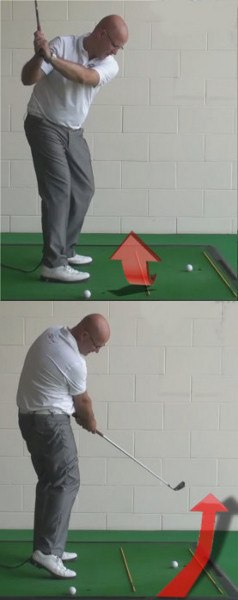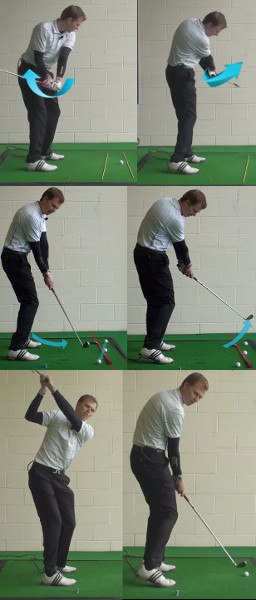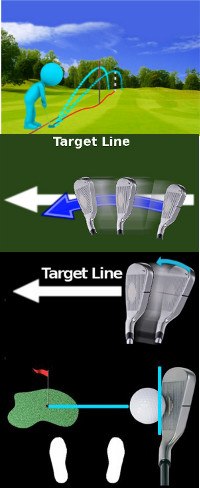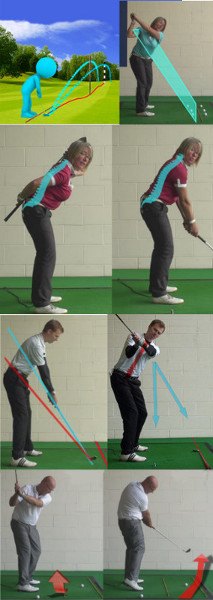A so-called “shotmaker” is a golfer who can control the ball's flight at will, hitting shots that curve left or right and fly low or high – whatever the situation calls for.
An often overlooked aspect of shotmaking, however, is the ability to start the ball in precisely the right direction.

The true shotmaker doesn't always achieve this through pinpoint alignment. He's able to manipulate his swing path in relation to the target, creating an inside-to-outside (draw) or outside-to-inside (fade) swing as needed. That's the essence of playing by feel – altering one's technique ever so slightly to produce a very specific result.
Here's a drill that will train your body to hit the ball right or left of the target on command. The drill is best performed using alignment rods, but you can get by without them:
- On the range, choose a target such as a yardage marker or distant tree.
- If you've got an alignment rod, stick it in the ground 5-8 yards from your ball and directly in line with the target. Otherwise, place an object (golf ball, headcover) directly on the line.
- Place a second rod or a club parallel to the target line next to your ball; you'll use this to align your feet.
- With a short iron, line up to hit the ball straight at the target object – feet, hips and shoulders square to the line.
- Without changing your body alignment and swinging at about 75% power, try to start the first shot just right of the target. Try to hit the next one just left.
- After hitting five right and five left, go to full swings and repeat.
The key is to make sure your body stays lined up square to the target. That forces you to alter the swing path in order to start each shot on the desired line. In time, your hips, shoulders and arms will “figure out” how to produce the correct sequences.

Correct Swing Path to Start Shots On Line
Golf is a game which is all about hitting targets. If you can successfully hit your targets with a majority of your shots, you will shoot good scores. Even if you don't hit the ball very far – something most golfers obsess over – you can still shoot great scores if you are accurate swing after swing, all day long. Keeping the ball in position and out of trouble should be your main focus as you play, and doing so requires an impressive level of control over your swing mechanics. Players who are able to repeat their mechanics precisely are generally able to walk off the course with a quality score.
Using the correct swing path through the hitting area is one of the mechanical keys which will help you hit your targets. In this article, we are going to discuss the importance of using the right swing path to start your shots on line. When shots start on line, it is obviously far more likely that they will end up near their target as well. The ball can and will curve in the air, of course, so simply starting your shots on the target line is not the end of the challenge. It is a great start, however, and it will help you to be far more reliable when it comes to the accuracy of your game.
The term swing path refers the path the club traces as it moves through the hitting area. If your club is moving directly down the target line at impact, you are using a straight swing path – and you will likely be a rather accurate golfer. Swinging out to the right (for a right-handed golfer) is an inside-out swing path, which is often going to produce a draw. Swing across to the left of the target line, as you might guess, is known as an outside-in swing path. This is the path you will most likely want to avoid, as it commonly produces a slice. Once you decide which type of swing path you wish to use in your game, the job is then simple – repeat that path time after time, and match it up with proper aim and club face angle to produce accurate shots.
Proper swing path matters on each and every shot you hit on the course. From a tee shot you strike with a driver on down to a short putt, you need to manage your swing path successfully if you are going to be happy with your results. During practice, pay attention to your swing path and work on making it as consistent as possible. You don't necessarily have to swing perfectly down the line to play well – in fact, most players don't swing directly down the line. You do, however, need to repeat whatever path you use with great reliability. It is the consistency of your swing which will determine your ability on the golf course. Learn how to use the same path over and over again and you will play golf at a higher level than ever before.
All of the content below is written from the perspective of a right-handed golfer. If you happen to play left-handed, please take a moment to reverse the directions as necessary.

Which Path Will You Choose?
The path of your swing through the hitting area should not be an accident. It isn't good enough to simply swing the club and 'see what happens' – rather, you need to swing the club with purpose, intent, and a specific path in mind. The path of your swing is going to dictate largely the direction of the ball as it flies through the air, so this is a crucial piece of the overall golf puzzle.
For some players, the decision is simple – they will attempt to swing down the line as straight as possible each and every time. While that is certainly a viable option, it is not the only choice you can make. Some players feel more comfortable intentionally swinging from inside-out or outside-in, as this plan allows them to anticipate their ball flight more accurately. If you swing from inside-out, for example, you will very likely hit a right to left draw. This predictability has its advantages when compared to a straight down the line swing which may produce a small draw or small fade depending on the position of the face at impact.
To help you make a decision on which type of swing path you are going to use, we have provided some important points below.
- Inside-out for power. If it is swing speed that you are concerned with when building your technique, you will want to swing the club from inside-out. This is the most powerful way to swing the club, and it is the option that is going to produce the greatest distance for the majority of players. For one thing, you are simply in a more powerful position coming down when you swing from inside-out. The club is in close to your body as you near impact, and you can use aggressive rotation to whip it through the zone. Also, this type of swing usually creates a draw, which is a ball flight that will travel further than a fade hit with the same swing speed. In the end, the choice is clear if you are trying to maximize distance – build your swing around a path that moves from inside-out.
- Outside-in for control. You probably saw this one coming. If swinging on an inside-out path is going to help you develop more power, it only follows that an outside-in path is the best way to control your ball. Typically, players who hit a small fade have better control over the ball than do those who hit a draw. So, if you are a player who naturally possesses plenty of power, you don't really need to worry about hitting from inside-out to add even more force to your shots. Instead, you should think about swinging from outside-in to gain control over your ball flight. Many of the longest hitters on the PGA Tour actually play a fade because they have plenty of power to spare. Instead of drawing the ball to become even longer, they leverage their power through the use of a controlled, reliable fade.
- Down the line for consistency. For players who simply want to keep the ball in play as often as possible, swinging directly down the target line is a viable option. The advantage of this method is you are unlikely to hit any dramatic 'foul balls'. As long as the club is moving down the line nicely, you should be able to keep your shots within a relatively small margin of error. On the downside, you might find it hard to dial in your trajectory just perfectly as you will always be going back and forth between a fade and a draw. Since swinging down the line can produce either kind of shot, you will have to have excellent control over the club face in order to predict your shot shapes.
Only you can decide which swing path is going to be the best option for your game. Many amateurs will opt for the inside-out path because of the extra distance it offers, and that certainly is something to ponder. However, before you make your pick, be sure to think through all three options carefully. There is no right or wrong answer with this debate – you only need to find the one which will lead you to the lowest possible scores.

Correlating Swing Path and Target
The equation that needs to come together in order to send your golf ball perfectly toward the target is rather complicated. While you don't want to have to think about all of these details when playing on the course, there are actually many variables in play within a single swing. The list of elements which will impact your shots includes the following –
- The path of your swing
- The angle of the club face at impact
- The location of contact on the face of the club
- The target line you have selected for the shot
- The angle of attack (down or up) into impact
- The speed of your swing through the hitting area
Sadly, that list doesn't even cover everything that will go into determining the final result of your shot. If you have ever wondered why golf is such a difficult game, the list above should give you a good indication. It is obviously quite difficult to make sure that all of these variables are in place properly each time you swing the club.
One of the biggest jobs you have before any shot is to match up the swing path you are going to use with the target you have selected for the shot at hand. This is not as simple as just swinging for the target at hoping for the best. Imagine, for instance, that you are hitting a straightforward approach shot of 150 yards. This shot gives you very little to worry about, as there are no hazards in play and the hole is cut right in the middle of the green. In this case, you can just aim right at the hole, correct? Not so fast.
It is at this point that you need to think about the swing path and ball flight that you intend to use for the shot. If you are going to swing from inside-out, you will likely be producing a draw – which means you need to aim a bit to the right of the target in order to give your ball room to move back toward the hole as it flies. If you aim directly at the flag and proceed to hit a draw, your ball will miss left. The exact amount that you need to adjust your aim to the right will depend on the severity of your draw, so you have to practice mastering your aim on the driving range before you can execute successfully on the course.
The challenge of matching up your swing path and ball flight to your targets is why you should stick with one ball flight for most of your shots. It is a nice idea to attempt to vary your ball flights as you play based on the shot at hand, but this is a skill which is beyond all but the best golfers. To dial in your game to the highest possible level of consistency, it is best to work on hitting the same kind of ball flight over and over again. Sure, you can turn to the opposite ball flight when you need to navigate around an obstacle, but the majority of your shots should be following the same pattern. If you stick with this kind of consistent plan you are going to get better and better at controlling your shots over time.

Improving the Consistency of Your Swing
With all of the talk so far about making a consistent swing which traces the same path time after time, you are probably wondering one thing – how do I achieve a consistent swing path? While there is no one single fundamental you can add to your swing in order to be more consistent, there are a few things you can work on during your trips to the range. Pay attention to the following points as you practice your swing and your swing path should become more and more reliable.
- Balance. If you want to play consistent golf, you need to be balanced as you swing – it's just that simple. If you are off balance in your swing, it will be nearly impossible to move the club through the hitting area in the same way time after time. Balance is perhaps the single most important fundamental in the game, and it is something you should be working on each time you practice. Do your best to keep your weight evenly distributed between your two feet during the swing and rotate aggressively toward the target on the way down. Once you have managed to improve your balance to the point where it is a strength, you should find that your swing path is more consistent than ever.
- Repeatable takeaway. It is important to take the club back on the same path each time you start your swing. Some players like to take the club back straight away from the ball along the target line, while others like to take it slightly inside or outside. You can work on finding your own 'sweet spot' with regard to the takeaway, but do your best to repeat that path once you find it. Even if you aren't at the driving range or course, consider spending a few minutes each day working on your takeaway. Grab a club, take your stance, and repeat your takeaway a few times without actually making a swing. In time, this simple practice drill will help you trace a perfect path through the ball over and over again.
- Consistent grip. The grip is one of the parts of the swing which is frequently overlooked by amateur golfers. To fine tune your swing path, pay attention to the consistency of your grip. You should be holding the club in the same manner each time you make a swing, with each hand in exactly the same position (with the exception of moving down the grip on occasion to reduce distance). Again, this is something you can practice even when you are away from the course. Pick up one of your clubs when you have a spare minute or two and form your grip a few times. It won't take long before your grip becomes second nature and incredibly consistent from shot to shot.
- Set your shoulders properly. As you establish your stance over the ball, you likely pay attention mostly to your lower body. With your feet in the right place and your knees flexed, you will feel like you are good to go. There is a little more to it than that, however, as you need to make sure your shoulders are set correctly at address as well. Before your swing begins, take a moment to confirm that your shoulders are squared up with your feet. With all of your 'lines' now coordinated properly, you can proceed with the swing.
With the average round of golf taking well over four hours, it is naturally difficult to make the same kind of swing all day long. There is plenty of time to lose track of your fundamentals and mechanics as the round wears on, which is why it is so important to spend time mastering your technique on the range. If you can use the simple points above to refine your swing in the weeks and months to come, you should find that your shots will begin to find their target with improved regularity.

Swing Path in the Short Game
Everything is simplified when you move from the long game into the short game. Rather than talking about hitting the ball hundreds of yards, you are now thinking about hitting the ball just a few feet, in some cases. As you might imagine, this greatly simplifies the discussion that needs to be had with regard to swing path. While many of the variables are stripped away when it comes to the short game, you do still need to think about swing path in order to succeed with your putts and chip shots.
The first thing to note in the short game is that you don't have to think about the curve of the ball. You aren't going to hook or slice a putt, obviously, and you won't need to worry about curve on your chip shots either. The ball simply isn't in the air long enough, and doesn't have a high enough spin rate, to have to worry about curve with chip and even pitch shots. The line the ball leaves on is the line it will take until it comes down.
By taking any possibility of a curve out of the picture, you are really down to just two variables to consider in the short game – swing path and face angle. A shot which is hit with a straight swing path and a square face will head directly toward the target every time. There are other issues to think about after the ball leaves the club, like the slope and speed of the green, but hitting your target line just comes down to using a good path and keeping the face square. Obviously, those two tasks are easier said than done, so you will need to invest significant practice time if you wish to succeed in the short game.
To work on improving your swing path when chipping and putting, consider using a visual aid on the ground to guide your swing or stroke. Place another club on the ground – long irons work great for this purpose – and use it to trace your path through the ball. As long as you generally follow the straight line which has been created by the club on the ground, you will know you are moving in the right direction. Hit a few practice putts or chips with a club on the ground as a guide, then remove that club for a few more shots. It shouldn't take long before your short game swing path is headed directly for the target on a consistent basis.
Mastering the art of using the same swing path time after time is something that every serious golfer needs to put on their list. The swing path you use has everything to do with the accuracy of your shots, so don't make the mistake of taking this point for granted. Through some consistent work on the driving range you can gradually improve the way you move the club through impact. Pick out the right swing path for your game, work on perfecting it, and look forward to seeing the results out on the course. Good luck!






